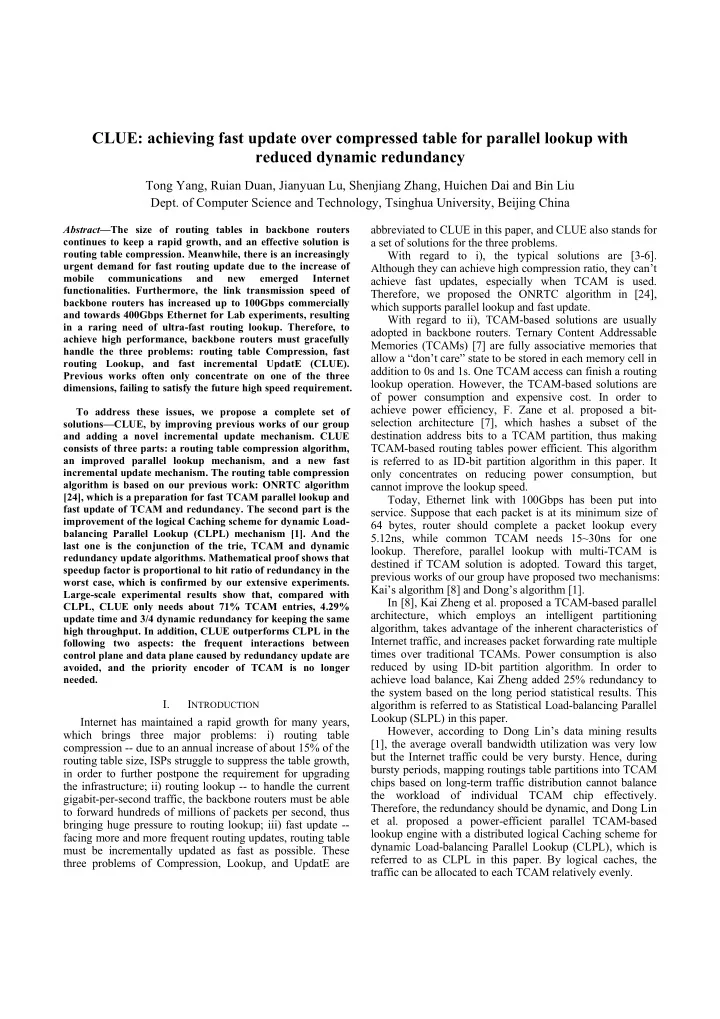

CLUE: achieving fast update over compressed table for parallel lookup with reduced dynamic redundancy Tong Yang, Ruian Duan, Jianyuan Lu, Shenjiang Zhang, Huichen Dai and Bin Liu Dept. of Computer Science and Technology, Tsinghua University, Beijing China Abstract —The size of routing tables in backbone routers abbreviated to CLUE in this paper, and CLUE also stands for continues to keep a rapid growth, and an effective solution is a set of solutions for the three problems. routing table compression. Meanwhile, there is an increasingly With regard to i), the typical solutions are [3-6]. urgent demand for fast routing update due to the increase of Although they can achieve high compression ratio, they can’t mobile communications and new emerged Internet achieve fast updates, especially when TCAM is used. functionalities. Furthermore, the link transmission speed of Therefore, we proposed the ONRTC algorithm in [24], backbone routers has increased up to 100Gbps commercially which supports parallel lookup and fast update. and towards 400Gbps Ethernet for Lab experiments, resulting With regard to ii), TCAM-based solutions are usually in a raring need of ultra-fast routing lookup. Therefore, to adopted in backbone routers. Ternary Content Addressable achieve high performance, backbone routers must gracefully Memories (TCAMs) [7] are fully associative memories that handle the three problems: routing table Compression, fast allow a “don’t care” state to be stored in each memory cell in routing Lookup, and fast incremental UpdatE (CLUE). addition to 0s and 1s. One TCAM access can finish a routing Previous works often only concentrate on one of the three lookup operation. However, the TCAM-based solutions are dimensions, failing to satisfy the future high speed requirement. of power consumption and expensive cost. In order to achieve power efficiency, F. Zane et al. proposed a bit- To address these issues, we propose a complete set of selection architecture [7], which hashes a subset of the solutions—CLUE, by improving previous works of our group destination address bits to a TCAM partition, thus making and adding a novel incremental update mechanism. CLUE consists of three parts: a routing table compression algorithm, TCAM-based routing tables power efficient. This algorithm an improved parallel lookup mechanism, and a new fast is referred to as ID-bit partition algorithm in this paper. It incremental update mechanism. The routing table compression only concentrates on reducing power consumption, but algorithm is based on our previous work: ONRTC algorithm cannot improve the lookup speed. [24], which is a preparation for fast TCAM parallel lookup and Today, Ethernet link with 100Gbps has been put into fast update of TCAM and redundancy. The second part is the service. Suppose that each packet is at its minimum size of improvement of the logical Caching scheme for dynamic Load- 64 bytes, router should complete a packet lookup every balancing Parallel Lookup (CLPL) mechanism [1]. And the 5.12ns, while common TCAM needs 15~30ns for one last one is the conjunction of the trie, TCAM and dynamic lookup. Therefore, parallel lookup with multi-TCAM is redundancy update algorithms. Mathematical proof shows that destined if TCAM solution is adopted. Toward this target, speedup factor is proportional to hit ratio of redundancy in the previous works of our group have proposed two mechanisms: worst case, which is confirmed by our extensive experiments. Kai’s algorithm [8] and Dong’s algorithm [1]. Large-scale experimental results show that, compared with In [8], Kai Zheng et al. proposed a TCAM-based parallel CLPL, CLUE only needs about 71% TCAM entries, 4.29% architecture, which employs an intelligent partitioning update time and 3/4 dynamic redundancy for keeping the same algorithm, takes advantage of the inherent characteristics of high throughput. In addition, CLUE outperforms CLPL in the Internet traffic, and increases packet forwarding rate multiple following two aspects: the frequent interactions between times over traditional TCAMs. Power consumption is also control plane and data plane caused by redundancy update are reduced by using ID-bit partition algorithm. In order to avoided, and the priority encoder of TCAM is no longer needed. achieve load balance, Kai Zheng added 25% redundancy to the system based on the long period statistical results. This I. I NTRODUCTION algorithm is referred to as Statistical Load-balancing Parallel Lookup (SLPL) in this paper. Internet has maintained a rapid growth for many years, However, according to Dong Lin’s data mining results which brings three major problems: i) routing table [1], the average overall bandwidth utilization was very low compression -- due to an annual increase of about 15% of the but the Internet traffic could be very bursty. Hence, during routing table size, ISPs struggle to suppress the table growth, bursty periods, mapping routings table partitions into TCAM in order to further postpone the requirement for upgrading chips based on long-term traffic distribution cannot balance the infrastructure; ii) routing lookup -- to handle the current the workload of individual TCAM chip effectively. gigabit-per-second traffic, the backbone routers must be able Therefore, the redundancy should be dynamic, and Dong Lin to forward hundreds of millions of packets per second, thus et al. proposed a power-efficient parallel TCAM-based bringing huge pressure to routing lookup; iii) fast update -- lookup engine with a distributed logical Caching scheme for facing more and more frequent routing updates, routing table dynamic Load-balancing Parallel Lookup (CLPL), which is must be incrementally updated as fast as possible. These referred to as CLPL in this paper. By logical caches, the three problems of Compression, Lookup, and UpdatE are traffic can be allocated to each TCAM relatively evenly.
Recommend
More recommend